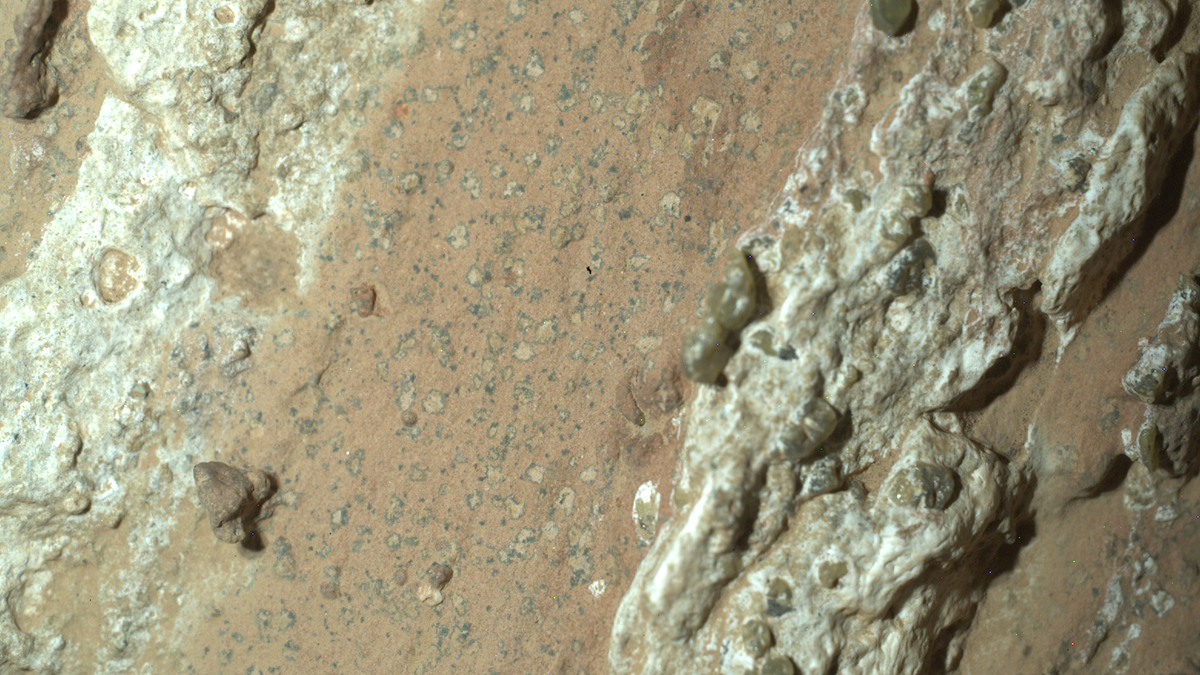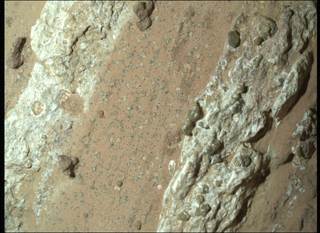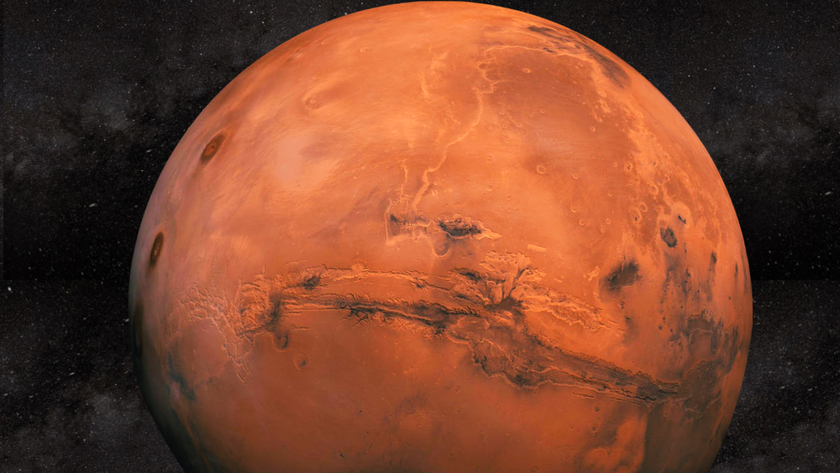Possible signs of Mars life: Astrobiologist explains Perseverance rover's exciting find
"This is not a slam dunk by any means — there's multiple lifetimes of questions to address."

The search for extraterrestrial life is as much about basic biology, geology and chemistry as it is about seeking to understand our place in the universe. The former came into the spotlight last month, when NASA's Perseverance rover found a rock with features and chemistry that could have been produced by ancient microbial life on Mars.
On July 21, the rover sampled an arrow-shaped rock, which scientists have nicknamed Cheyava Falls after the highest waterfall in Arizona's Grand Canyon, and found that it hosts organic compounds, which are the building blocks of life as we know it. Wisping through the length of the rock are veins of calcium sulfate, whose presence suggest a fluid — very likely water — once flowed through the rock. Finally, the rock is speckled with white spots with black rims, in which the rover's instruments detected iron phosphate molecules. On Earth, similar "leopard spots" are indicative of fossilized records of microbes. In the Cheyava Falls Mars rock, they may be signs of chemical reactions that occurred billions of years ago, which could have served as an energy source for ancient microbial life, the Perseverance science team shared in a NASA statement on July 25.
Taken together, these features are a potential biosignature — intriguing signs that the rock was once home to conditions typically linked to microbial life. While scientists on the Perseverance team are very excited about the rock, they stressed that they did not detect anything that could be fossilized organisms. It is also worth noting that the Perseverance rover isn't designed to detect and confirm alien life; it's collecting samples of scientific interest that will be returned to Earth for further scrutiny.
Perhaps the Cheyava Falls rock could one day address a question that has existed for as long as humans have looked skyward: Are we alone in the universe?
Related: NASA's Perseverance Mars rover finds possible signs of ancient Red Planet life
The answer may very well land on Earth before the end of next decade, if NASA's troubled Mars Sample Return program pans out and delivers those precious samples home, where scientists can scrutinize them with a greater variety and complexity of instruments than Perseverance can carry.
"The discovery of life beyond Earth is so profound, so paradigm-shifting, you have to get it right," Amy Williams, an astrobiologist at the University of Florida who's on the Perseverance science team, told Space.com in a recent interview. "Once you cross that line, you can't come back."
Get the Space.com Newsletter
Breaking space news, the latest updates on rocket launches, skywatching events and more!
Space.com sat down with Williams to discuss what makes the Cheyava Falls sample so special, alternate explanations to alien life being considered by the mission team and the role Mars Sample Return would play in vetting the discovery.
The interview has been edited for length and clarity.

Space.com: What is it about Cheyava Falls that makes it so exciting in the search for alien life?
Amy Williams: This is the most compelling organics signal detection the rover has made so far. [The presence of organics] is always going to be a way for us to triage samples of interest; organic carbon makes up all life as we know it on Earth. But it's important to note that organic carbon can be made abiotically, i.e., without life. It can be made by geologic processes, and it's made on meteorites that were delivered to the surface of Mars over its history.
The leopard spots' texture is one of the things that can also help us identify a region or rock of interest. These spots are circular features of white mineral, and they've got a rim of a dark mineral around them. Using our instrument suite, we're able to determine it contains iron phosphate, and these kinds of features are often associated with microbial life on Earth. Seeing a texture like that, where you have these different redox phases in close proximity to each other, catches our attention, because that is the kind of thing that life could use as an energy source.
We often see calcium sulfate veins cross cutting across a variety of rocks on Mars. It might be that fluids were flowing through the rocks and they deposited those veins; we just drove up off of a delta fan structure, so we know that there was water here in the ancient past.
All of these together are giving us this sense for an environment that was habitable in the ancient past, and some aspects of these features could be consistent with things we see on Earth that are associated with microbial life. That's why the excitement is here, and why we want to explore these rocks more.
Space.com: Why can't Perseverance conclusively detect life on Mars?
Williams: The instrument suite onboard Perseverance is meant to triage samples for collection and return to Earth. There are no life-detection instruments onboard the rover.
There are a lot of parties that discuss what it would mean to have conclusive evidence for life on Mars. There are a lot of ways to approach it, and people want to be very conservative about it because once you cross that line, you can't come back. The discovery of life beyond Earth is so profound, so paradigm-shifting, you have to get it right. That's why it's so exciting to see a sample like this, because we have an opportunity to explore that space, to see if we found that evidence.
The instrument [suite] onboard Perseverance is not made to make that detection and confirmation; it's really the analyses that we can perform back on Earth. For the first time in our history of Mars exploration, we really have a good chance of being able to say something about whether there is evidence for ancient life on Mars or not.
Space.com: What's the mood like within the Perseverance team?
Williams: There's excitement in the team of finding something novel, whether or not there's evidence of life in this rock. It brings fresh energy to the team when we're working on something that has potential to reveal so much about Mars. There's always excitement when we collect a sample, and this sample in particular has been awe-inspiring — you take a moment to think about the amazing stuff that this team has been doing and NASA has been doing on Mars and other planetary bodies, so it's a cool time to step back and appreciate what we're all working toward.
Space.com: What alternate explanations is the team considering for the newfound features in the Cheyava Falls rock?
Williams: We're still trying to understand the environmental context for the rock in which this sample came from. For example, we found it close to where two rocks come together, and we're trying to understand that relationship. We don't know if these rocks were heated at all in the past — could that have driven any kind of rezoning of the elements? Nearby to those samples are these veins that contain a mineral called olivine — a big crystal made in magmas. Is that related to something that was way up the river valley and was brought in? Is it primary, in which case, how do you reconcile an environment that would be hot enough to have a magma but then also would have this organic carbon? If it were biologic, how do you reconcile that? These are questions that we are certainly grappling with now.
Our goal with the mission has always been to collect the most interesting samples for return to address these profound questions. This is not a slam dunk by any means. There's multiple lifetimes of questions to address.
Related: Possible sign of Mars life? Curiosity rover finds 'tantalizing' Red Planet organics
Space.com: What instruments on Earth could help us find ancient life on Mars?
Williams: We basically have every instrument that the global scientific community can lend.
If you want to look at organic carbon, there are so many ways to detect organic carbon and to learn details about its structure that Perseverance doesn't have right now. You can do mass spectrometry analyzes to learn more about organic carbon present in that signal we're getting from SHERLOC [one of Perseverance's instruments]. Then, you have the potential to say something about the origin of that material: "This is so complex that maybe life made it because we don't know about abiotic process that can make it," or "This looks just like what you would see in a meteorite, [so] there's no reason that it would be been made by life," or [perhaps] you still cannot say either way.
When you bring samples back, depending on what they're made of, we should be able to get ages on them. You can [then] tell something about when water was flowing on Mars. If we did think there was life, you can potentially be able to say how long ago it might have been there. There's all these paths you can go down and start to extrapolate. That's just on the astrobiology side of things — the tiniest wedge of things that I do and am excited about — but there's this whole pie of exciting science that we get to do with these samples if we can have them returned.
Space.com: We don't know what alien life looks like, so what would the search for it entail? For instance, would it be an elimination game where we rule out abiotic processes, or do we have a comprehensive catalog of signals from living organisms to tally the Cheyava Falls sample with?
Williams: The concept of life as we don't know it is always around the corner, and something that we should consider — even on a world that is seemingly as similar to Earth as Mars is.
What you're looking at is [whether] you see multiple lines of evidence that all point in either a biotic direction or an abiotic direction. In some ways, the most challenging answer would be both, because then it's still an ambiguous answer and you can't dissociate between the two. That is science.
Do we have a catalog of, "This is what biologic looks like, and this is what abiotic processes make?" Yes, and it's still evolving. I predict that if you bring a Mars sample home, scientific energy and research will turn in the direction of how you can separate out the gray areas of abiotic and biotic, and how we can refine how that space is determined to be able to say something specific about these extraordinary samples from Jezero Crater.
Related: Perseverance rover's Mars rock sample may contain best evidence of possible ancient life
Space.com: How is the Perseverance rover doing? What's next for the mission?
Williams: I like to think that she's a happy rover, that she gets some joy from doing this.
The rover is performing fantastic. We are finishing up the margin of Jezero Crater. Our plan has always been to climb out of the Jezero Crater and explore this really ancient Noachian terrain — one of the earliest time periods on Mars where there was water. Getting into a timeframe that we really haven't explored in situ before is extremely exciting.
It's great to have this excitement and momentum behind this. It makes everyone recognize the important contributions that we are making to the scientific community. It also gives me a lot of inspiration and hope about the kind of motivation for future scientists if these samples can come back. I just talked with a group of high schoolers, and I said, "You all are of the age where you can be the scientists working on these samples." That's incredible to me.
These samples will be revolutionary. They're volumetrically small, but their importance dwarfs their size. So many future generations will learn extraordinary things about Earth from Mars, Mars about Mars, exoplanets … the list keeps going. There are questions we don't even know to ask yet that these samples give us the opportunity to do so.
Join our Space Forums to keep talking space on the latest missions, night sky and more! And if you have a news tip, correction or comment, let us know at: community@space.com.

Sharmila Kuthunur is a Seattle-based science journalist focusing on astronomy and space exploration. Her work has also appeared in Scientific American, Astronomy and Live Science, among other publications. She has earned a master's degree in journalism from Northeastern University in Boston. Follow her on BlueSky @skuthunur.bsky.social











